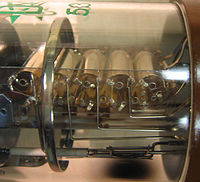
Photo from wikipedia
A high-speed temperature diagnostic based on spontaneous Raman scattering (SRS) was demonstrated using a pulse-burst laser. The technique was first benchmarked in near-adiabatic ${{\rm H}_2} \text{-} {\rm air}$ flames at… Click to show full abstract
A high-speed temperature diagnostic based on spontaneous Raman scattering (SRS) was demonstrated using a pulse-burst laser. The technique was first benchmarked in near-adiabatic ${{\rm H}_2} \text{-} {\rm air}$ flames at a data-acquisition rate of 5 kHz using an integrated pulse energy of 1.0 J per realization. Both the measurement precision and accuracy in the flame were within 3% of adiabatic predictions. This technique was then evaluated in a challenging free-piston shock tube environment operated at a shock Mach number of 3.5. SRS thermometry resolved the temperature in post-incident and post-reflected shock flows at a repetition rate of 3 kHz and clearly showed cooling associated with driver expansion waves. Collectively, this Letter represents a major advancement for SRS in impulsive facilities, which had previously been limited to steady state regions or single-shot acquisition.
Journal Title: Optics letters
Year Published: 2021
Link to full text (if available)
Share on Social Media: Sign Up to like & get
recommendations!